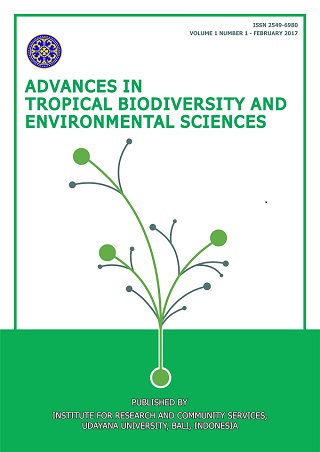Increase Banana Production with Various Applications of Organic Fertilizers
Abstract
Banana is a fruit that must be present in every activity of the Balinese people. Almost in every cultural and religious activity it is compulsory to present the banana fruit, even more Bali as a tourism area really need fruits including bananas. Therefore the need of bananas is highly demanded in traditional markets or supermarkets in Bali. Until now, the banana production in Bali is far below demand, therefore we still import form places outside of Bali. Banana has a high nutrient value due to nutrients found in it such as potassium and folic acid that is needed by the body. It is also a good so urce of calcium, phosphor, nitrogen, and vitamins such as vitamin A, vitamin C, and B complexes which helps to repair and regenerate tissues of the body. Banana plants can grow in many places, from low grounds until highlands and in various types of soil. Nevertheless for the optimal growth; fertile soil, crumbly thick, lots of humus, aeration, and a good drainage as well as enough water is all needed. By optimizing land use, banana plants are often planted as a sideline plant for plantatio n of coconut, cocoa, and coffee, as well as sideline plants for many other in-between plantations. The way of planting the banana is a conventional method that is commonly used by local farmers including those in the Angkah village. For growth of banana plants we must consider and ensure before planting a crumbly soil when it is solid, to make drainage, and to make levels in slopes. During plantation organic/compost fertilizers is needed as much as 15-20 kg for each hole for plantation. Organic fertilizers that are added influences the good production for both quantity and quality which makes the fruit tastier and has a higher nutritional value. There are some types of organic fertilizers that are used in this research that are: cow waste organic fertilizer, chicken waste organic fertilizer, pig waste organic fertilizer, goat waste organic fertilizer, and compost fertilizer with a dosage of 15 kg per plant. The placement of fertilizers for each places of treatment is conducted b y using a Random Group Design (RGD). The total treatments are 6 and are repeated 3 times. Planting is conduct ed on the 7th of July 2016 with a ground hole size of 60cmx60cm and a depth of 50 cm. The seedlings that are used are decedents that are 50-65cm in height. The specific aim that is wished to be achieved is the increase production of banana as sustainable food in Indonesia. The result up to the progress of this research was found that treatment with chicken waste fertilizer has given the best influence for growth of the banana plant, increased number of leaves, as well as increased height of the plants, all compared to the controlled. The increment of banana plant with chicken waste fertilizer was 63.33 cm for 3 months.
Keywords: Banana, Nutritional Values, Production, Organic Fertilizer













